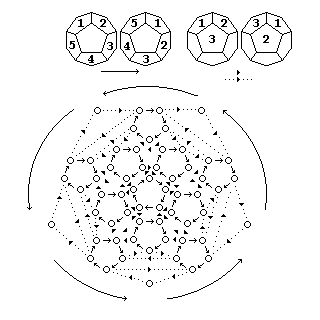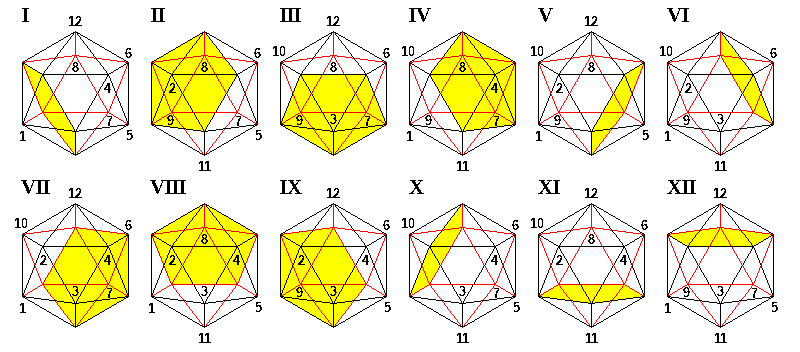
The following image shows the possible orientations of a dodecahedron, laid out symmetrically:

and the following diagram is a key to the layout of the pattern:

You may remember, when you were young, attempting to solve a sliding-block puzzle that looked like this:
---------------- |[ 1][ 2][ 3][ 4]| |[ 5][ 6][ 7][ 8]| |[ 9][10][11][12]| |[13][14][15] | ----------------
and you may have read the story about how some combinations were impossible: those that involved switching the positions of exactly two adjacent tiles.
The group formed by all possible permutations of 15 objects is called S15, or the symmetric group of order 15, and the group of even permutations only, the ones reachable in this puzzle, is called the alternating group of order 15, or A15.
The group formed by the rotations of the dodecahedron (the operation being first perform one rotation, then the other) is isomorphic to the group of even permutations of five objects, or A5.
The dodecahedron (and the icosahedron, and also the rhombic tricontahedron, the shape of a perfect garnet and the shape of the 30-sided dice offered for use in RPG games) has a symmetry with many interesting mathematical properties.
A book once explained the proof in Galois theory that quintic equations cannot be solved by radicals in terms of the dodecahedron.
Also, the binary Golay code, which is the only nontrivial perfect error-correcting code (with the optional addition of a parity bit) other than the Hamming codes (which also may have a parity bit optionally added) can be represented in terms of the symmetries of the dodecahedron. One form of it which was related to the dodecahedron is this one:
1 0 0 0 0 0 0 0 0 0 0 0 1 0 0 0 0 0 1 1 1 1 1 1 0 1 0 0 0 0 0 0 0 0 0 0 0 1 0 1 1 0 1 1 0 0 1 1 0 0 1 0 0 0 0 0 0 0 0 0 0 0 1 0 1 1 1 1 1 0 0 1 0 0 0 1 0 0 0 0 0 0 0 0 0 1 0 1 0 1 0 1 1 1 0 1 0 0 0 0 1 0 0 0 0 0 0 0 0 1 1 0 1 0 0 0 1 1 1 1 0 0 0 0 0 1 0 0 0 0 0 0 0 0 1 1 0 1 1 0 0 1 1 1 0 0 0 0 0 0 1 0 0 0 0 0 1 1 1 0 0 1 1 0 1 1 0 0 0 0 0 0 0 0 0 1 0 0 0 0 1 1 1 1 0 0 0 1 0 1 1 0 0 0 0 0 0 0 0 0 1 0 0 0 1 0 1 1 1 0 1 0 1 0 1 0 0 0 0 0 0 0 0 0 0 1 0 0 1 0 0 1 1 1 1 1 0 1 0 0 0 0 0 0 0 0 0 0 0 0 1 0 1 1 0 0 1 1 0 1 1 0 1 0 0 0 0 0 0 0 0 0 0 0 0 1 1 1 1 1 1 1 0 0 0 0 0 1
Note that this version, encoding 12 bits to 24, is a version of the form of the Golay code with the parity bit added, but, in this case, hidden.
However, of late, a different form of the Golay Code with a direct relation to the dodecahedron seems to appear more commonly - because it's embodied in a graphical image of the matrix provided to the public domain by one Life of Riley, which appears both in Wikipedia and on a page of the American Mathematical Society. However, I don't think it's enough to just say that something is related to the dodecahedron, or its dual, the icosahedron. So, instead, I'm going to try to provide a diagram from which the relationship is visible.

The Roman numerals from I to XII refer to the yellow pentagons, and the Hindu-Arabic numbers in each diagram refer to the twelve vertices of the icosahedron. Note that in each figure, the numbers corresponding to the corners of the yellow pentagon are omitted.
And so, we get our version of the binary Golay Code by taking the numbers that are not omitted in each diagram, like this:
I II III IV V VI VII VIII IX X XI XII
1 0 0 0 0 0 0 0 0 0 0 0 1 0 0 1 1 1 1 1 0 0 0 1 1
0 1 0 0 0 0 0 0 0 0 0 0 0 1 0 0 1 1 1 1 1 0 1 0 2
0 0 1 0 0 0 0 0 0 0 0 0 0 0 1 0 0 1 1 1 1 1 0 1 3
0 0 0 1 0 0 0 0 0 0 0 0 1 0 0 1 0 0 1 1 1 1 1 0 4
0 0 0 0 1 0 0 0 0 0 0 0 1 1 0 0 1 0 0 1 1 1 0 1 5
0 0 0 0 0 1 0 0 0 0 0 0 1 1 1 0 0 1 0 0 1 1 1 0 6
0 0 0 0 0 0 1 0 0 0 0 0 1 1 1 1 0 0 1 0 0 1 0 1 7
0 0 0 0 0 0 0 1 0 0 0 0 1 1 1 1 1 0 0 1 0 0 1 0 8
0 0 0 0 0 0 0 0 1 0 0 0 0 1 1 1 1 1 0 0 1 0 0 1 9
0 0 0 0 0 0 0 0 0 1 0 0 0 0 1 1 1 1 1 0 0 1 1 0 10
0 0 0 0 0 0 0 0 0 0 1 0 0 1 0 1 0 1 0 1 0 1 1 1 11
0 0 0 0 0 0 0 0 0 0 0 1 1 0 1 0 1 0 1 0 1 0 1 1 12
thus, it is possible to actually see that the matrix above has a relationship to the icosahedron.